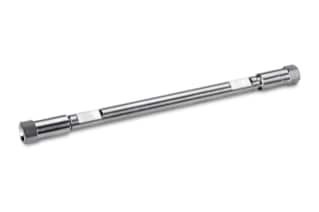
|
Chemistry |
C18 |
|
Separation Mode |
Reversed Phase |
|
Particle Substrate |
Silica |
|
pH Range Min |
3 pH |
|
pH Range Max |
7 pH |
|
Maximum Pressure |
6000 psi (415 Bar) |
|
Endcapped |
Yes |
|
Bonding Technology |
dC18 |
|
Silanol Activity |
Medium |
|
Particle Shape |
Spherical |
|
Particle Size |
5 µm |
|
Endfitting Type |
Waters |
|
Pore Size |
100 Å |
|
Format |
Column |
|
Surface Area |
330 |
|
System |
HPLC |
|
USP Classification |
L1 |
|
Inner Diameter |
2.1 mm |
|
Length |
100 mm |
|
Carbon Load |
12 % |
|
UNSPSC |
41115709 |
|
Brand |
Atlantis |
|
Product Type |
Columns |
|
Units per Package |
1 pk |

Atlantis dC18 Column, 100Å, 5 µm, 2.1 mm X 100 mm, 1/pk
A universal C18 analytical column that works with both LC and MS is the Atlantis dC18 column. It has been constructed to produce an excellent balance of retention for polar and nonpolar molecules while displaying limited retention of hydrophobic substances, in contrast to conventional reversed-phase HPLC columns. The Atlantis dC18 Column has better pH stability and is suitable with water mobile phases. This equipment's carefully designed packing material, which allows retention and separation of polar, water-soluble compounds, makes the silica-based, di-functionally bonded C18 material an appropriate piece of lab equipment for reversed-phase HPLC.
Polar compound retention is accomplished using Atlantis dC18 columns, which are universal, silica-based, reversed-phase C18 columns. Di-functionally bound C18 ligands that have been specially designed for usage with extremely aqueous mobile phases, such as 100 percent water, are present in the Atlantis dC18 columns.
With the Atlantis dC18 Column, you may achieve enhanced peak shape, low pH stability, improved polar compound retention, and resistance to hydrophobic collapse by combining optimal stationary phase properties such as end-capping, silica pore size, ligand type, and bonded phase ligand density (dewetting). One of the best reversed-phase HPLC columns, the Atlantis dC18 Column, is suitable for both polar compound separation and common reversed-phase applications. The Atlantis dC18 column's di-functional silane bonding chemistry offers good stability under acidic mobile conditions, a longer column lifespan, and low pH stability.
With the right lab equipment, you can boost your productivity. Visit our website to shop for lab equipment and learn more about the different models of a given product, such as the Atlantis dC18 Column, or to discover complementary items that go with it.
You should also check out Atlantis Silica dC18 VanGuard Cartridge, 100Å, 5 µm, 2.1 mm X 5 mm, 3/pk; Atlantis dC18 VanGuard Cartridges are used to extend analytical column lifetime and performance by removing particulate contamination from the mobile phase stream. This cartridge is optimized to protect all 2.1 mm and 3.0 mm I.D. Atlantis dC18 analytical columns containing 5 µm sorbent particles.
How Can Filtration Be Performed?
To facilitate the removal of air from the syringe, it is recommended to draw approximately 1 mL of air into the device prior to adding the sample. This allows the air to be expelled along with the sample, reducing fluid retention in the filter device through an "air purge" mechanism. Once the solution is filtered, it can be injected into the syringe. Attach the filled syringe to the filter device by gently twisting it, using moderate force without exerting excessive pressure. Initiate the filtration process by applying light pressure.